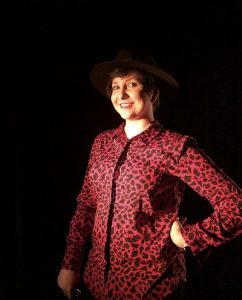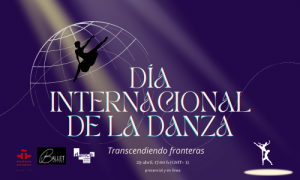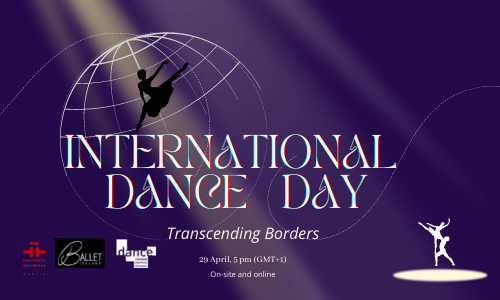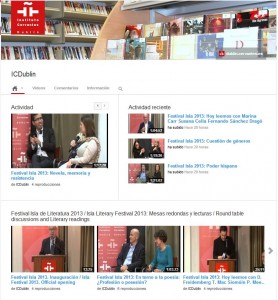Blog del Instituto Cervantes de Dublín
Torre Martello
El conservatorio de danza | The Dance Conservatory
Con motivo del Día Internacional de la Danza, Laura Bruña (directora de ensayos de Ballet Ireland) comparte con nosotros un retazo de su infancia y sus inicios en el mundo de la danza. El 29 de abril, moderará la mesa redonda Trascendiendo fronteras, organizada por el Instituto Cervantes de Dublín, junto a Ballet Ireland y Dance Ireland.
Cuando era pequeña tenía que salir corriendo del colegio para llegar puntual a mis clases de ballet. Tuve la suerte de estudiar en un conservatorio de danza, lugar que mis compañeros y compañeras del colegio creían que era para conservar o hacer experimentos. A mí me hacía mucha gracia que creyeran eso cuando, en realidad, lo que hacía era formarme en una disciplina artística que, por desgracia, todavía es bastante desconocida para mucha gente: la danza.

Un conservatorio (institución pública del sector educativo español) es un centro de Enseñanza de régimen especial donde se ofrece una educación reglada oficial no obligatoria aunque, para mí —con ocho años—, era un lugar amable donde pasaba las tardes mientras me divertía al ritmo de la música; se puede decir que allí aprendí, sin darme cuenta, lo que hoy en día es mi profesión. A medida que iban pasando los años, aquel sentimiento de diversión se fue transformando en compromiso y disciplina, pero siempre con ese trasfondo lúdico cada vez que alcanzaba una meta técnica.
La mayoría de las veces, cuando eres estudiante, la prioridad es brillar técnicamente (aunque la técnica académica también tiene una parte artística). El lado más artístico llega en la preparación para subirte al escenario con el propósito de contar una historia, representar un concepto o sentimiento. En mis años de conservatorio “pisé mucho escenario” y el escenario curte. Desde muy pequeña aprendí que, con tu propio cuerpo y sin necesidad de la voz, puedes contar las historias que quieras y vivir como tuyas las vidas de muchos personajes. Eso fue lo que me enganchó.
La adolescencia, en el instituto y el conservatorio, no fue un camino de rosas. En ambos esperan lo mejor de uno. Por suerte, mis compañeros y yo, compartíamos aula en ambos lugares: ballet por las mañanas y bachillerato por las tardes. Allí todos sabíamos qué era un conservatorio, ya que era parte de nuestro día a día. Los pasillos del instituto (por cierto, de nombre Cervantes) se llenaban de grand jetés, pirouettes y portés en cada descanso, haciéndolo todo más llevadero y divertido. Supongo que en ese momento me di cuenta de que había dejado de ser aquella niña pequeña que admiraba a las chicas de los cursos superiores, a las que llamábamos “las mayores”, y me había convertido en una de ellas. Entonces llegaron los concursos, los cursos en el extranjero y las jóvenes compañías de verano. Todo me parecía poco y el conservatorio se hacía cada vez más pequeño.
No sé si fui yo quien decidió hacer de la danza mi profesión, o si fue la danza la que me eligió a mí. En cualquier caso, la danza es un lugar donde me siento cómoda —a pesar de su constante evolución e inestabilidad— y es una disciplina con la que he descubierto que puedes comunicarte de manera universal porque no tiene límites. La transición de estudiante de danza a bailarina profesional, ya si eso, la dejamos para otra ocasión.
Texto de Laura Bruña Rubio
On the occasion of the International Dance Day, Laura Bruña (Rehearsal Director, Ballet Ireland) shares with us her childhood memories and how she started to dance. Laura will chair the round table discussion Transcending Borders, on April 29, at Dance House; an initiative of the Instituto Cervantes Dublin, together with Ballet Ireland and Dance Ireland.
When I was a child, I had to rush from school to get to my ballet classes on time. I was lucky enough to study in a dance conservatory, a place that my classmates at school believed was to keep or experiment. This was very funny for me as, in reality, what I was doing there was being trained in an artistic discipline that, unfortunately, is still quite unknown to many people: dance.
A conservatory – a public institution in the Spanish education – is a special education centre that delivers non-compulsory official formal education. However, for me – at eight years old -, it was a friendly place where I spent the afternoons having fun to the rhythm of the music. I could say there is where I learnt, without realising it, what it is today my profession. As the years went by, that feeling of fun turned into commitment and discipline, but always with that playful undertone every time I achieved a technical goal.
As a student, most of the time the priority is to stand out for the technique skills (although academic technique also has an artistic side). The most artistic side emerges when you get ready to step onto the stage with the purpose of telling a story, representing a concept or feeling. During my years at the conservatory, “I was on stage a lot” and the stage does harden you. From a very early age I learned that, with your own body and no need for a voice, you can tell the stories you want and live the lives of many characters as your own. That’s what got me hooked.
My adolescence, in high-school and at the conservatory, was no bed of roses. In both they expected the best of myself. Luckily, my classmates and I shared a classroom in both places: ballet in the mornings and high-school in the afternoons. There we all knew what a conservatory was, since it was part of our daily life. The high-school corridors (named Cervantes, by the way) were filled with grand jetés, pirouettes and portés during the breaks, making everything easier and fun. I guess at that moment I realized that I was no longer the little girl who admired the girls in the upper classes – whom we called “the older ones” – and I had become one of them. Then came the competitions, the trainings abroad and the young summer companies. Everything seemed small to me and the conservatory became smaller and smaller.
I don’t know whether I chose dance as a profession or it was dance that chose me. In any case, dance is a place where I feel comfortable – despite its constant evolution and instability – and I have discovered that it allows me to communicate in a universal way because it has no limits. The transition from a dance student to a professional dancer… well, we will leave it for another occasion.
Text by Laura Bruña Rubio. Translation: Lola Rodríguez





